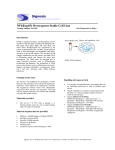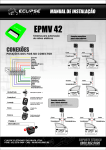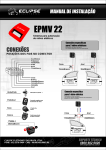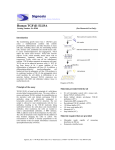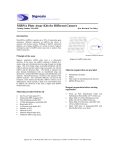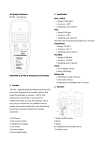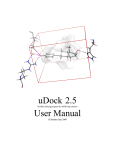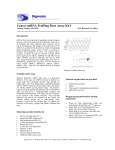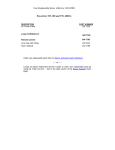Download User Manual
Transcript
Signosis Innovative Plate Assay Solutions Estrogen Receptor Luciferase Reporter T47D Stable Cell Line Catalog Number SL-0002 (For Research Use Only) Introduction Estrogen receptor (ER) belongs to nuclear receptor family and plays a widespread role in human physiology and in the development or progression of numerous diseases. In response to estrogen stimulation, estrogen bound receptor in the nucleus is dimerized and binds to specific response elements known as estrogen response elements (EREs) located in the promoters of target genes and regulates their gene expression. Signosis has established the T47D ER luciferase reporter stable cell line, in which the ERE and reporter luciferase gene are consistently expressed in the cell line to facilitate the screening and study. This stable cell line can provide a sensitive, responsive, and rapid in vitro system to detect and measure substances with potential (anti-)estrogenic activity. Principle of the assay The cell line was established by transfection of ER luciferase reporter vector along with neomycin expression vector followed by neomycin selection. The neomycin resistant clones were subsequently screened for 17 beta-estradiol induced luciferase activity. The clone with the highest fold induction (10 fold) was selected and expanded to produce this stable cell line. Materials provided One vial of 5 X 10^6 cells, at passage 2, in Freezing Media (store the vial in liquid nitrogen until it is ready to be thawed). Material required but not provided RPMI Fetal Bovine Serum (FBS) Penicillin (10,000 units/ml) Streptomycin(100ug/ml) Freezing media Luciferase reporter system (Promega E-1500) G418 (Roche) Fig.1: Stable cell line diagram Handling cells upon arrival It is strongly recommended that you propagate the cells by following instructions as soon as possible upon arrival. Genetic instability is a common in all transfected cells, therefore, it is critical to prepare numbers of frozen stocks at early passages. Prepare Initial Growth Media: RPMI (L-glutamine + Phenol Red) + Penicillin (100 units/mL) Streptomycin (100ug/ml) + 10% FBS) Prepare Complete Growth Media: RPMI (L-glutamine + Phenol Red) + Penicillin (100 units/mL) Streptomycin (100ug/ml) + 10% FBS + G418 (75ug/ml) Signosis, Inc. • 1700 Wyatt Drive Suite 10-12 • Santa Clara, CA 95054 • Tel 408 747 0771 • Fax 408 864 2182 Initial Culture Procedure Important: The first propagation of cells should be for generating stocks for future use. Cells undergo genotypic changes resulting in reduced responsiveness over time in normal cell culture conditions. Therefore, it is critical to prepare an adequate number of frozen stocks at early passages. 1. Quickly thaw cells in a 37 oC water bath with constant agitation. 2. Add 10 ml Complete Growth Media to a sterile 15 ml centrifuge tube then add entire contents of the vial to the media. 3. Spin at 2,000 rpm for 5 minutes. 4. Discard supernatant. 5. Add 1ml of Initial Growth Medium to suspend pellet. 6. Add 10ml of Initial Growth Medium to culture dish and transfer suspended pellet to culture dish containing Initial Growth Medium. 7. Pipette cells up and down to ensure the transfected cells are mixed well in the medium. 8. Place the culture dish with cells in a humidified incubator at 37 oC with 5% CO2. 9. After 48 hours, change to Complete Growth Media. 10. Change media every 2-3 days using Complete Growth Media. 11. When cells reach 90% confluency (usually within 1 week), prepare frozen stocks and continue propagate the rest of the culture for future assays. 12. Transfer vials from -80oC to liquid nitrogen for long term storage. Assay procedure The following procedure should be followed as a guideline. You will need to optimize the assay conditions based upon your experimental set up. 1. 2. 3. 4. 5. 6. 7. 8. 9. 10. 11. 12. 13. The day before performing the assay, trypsinize the cells and plate each well of a 96-well plate with 5 X 10^4 cells in 100ul. Incubate the plate in a humidified incubator at 37 oC with 5% CO2 overnight. Prepare inducing reagent at the optimal concentration in a 10ul volume. Add inducing reagent directly to each well and incubate for an appropriate time to produce maximal induction. Remove the media by aspiration and add 100ul of 1X PBS to each well. Remove the media by aspiration and add 50ul of lysis buffer to each well. Incubate cells in lysis buffer for a few minutes at room temperature. Rock culture dish several times to ensure complete coverage of the cells with lysis buffer. Pipette up and down to ensure complete lysis of cells. Perform one freeze-thaw cycle at -80oC and room temperature. Gently pipet up and down 2-3 times to mix. Transfer 20ul of each lysate to a new 96-well plate for the luciferase assay. Add 100ul of luciferase substrate to each well and gently pipette up and down. Immediately read the plate in a luminometer. Prepare frozen stocks 1. 2. 3. 4. 5. 6. 7. 8. 9. Carefully remove the culture media from cells by aspiration. Rinse cells with PBS, being careful to not dislodge attached cells. Then remove PBS by aspiration. Add 2ml of 0.25% Trypsin/0.53mM Tris-EDTA solution to the culture dish. Let the dish incubate with Trypsin for a few minutes or until cells have detached. Confirm detachment by observation under the microscope. Add 10ml of pre-warmed Complete Growth Media and gently pipette up and down to break the clumps. Transfer cells to a 15ml conical centrifuge tube and centrifuge at 2000 rpm for 5 minutes to collect the cells. Aspirate the culture media and resuspend cells at a density of 5 x 10^6 cells/mL in freezing media. Aliquot 1ml cells into cryogenic vials. Place vials in a freezing container and store at -80oC overnight. Data Example Fig. 2: T47D/ER-luc cells were treated with various concentrations in response to 17β-Estradiol The cells were seeded on a 96-well plate for overnight with DMEM including 10% FBS. The cells then were treated with or without 17B-Estradiol respectively in DMEM and 0.1% FBS for 16 hours. Signosis, Inc. • 1700 Wyatt Drive Suite 10-12 • Santa Clara, CA 95054 • Tel 408 747 0771 • Fax 408 864 2182


